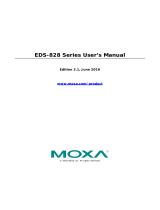
Table of Contents
1. MODBUS/TCP MAP ................................................................................................................................ 4
Introduction .......................................................................................................................................... 4
Data Format and Function Code ............................................................................................................... 4
Configuring MODBUS/TCP on Moxa Switches ............................................................................................. 4
MODBUS Data Map and Information Interpretation of Moxa Switches ........................................................... 5
2. EtherNet/IP ........................................................................................................................................ 12
Introduction ........................................................................................................................................ 12
Messaging Types ................................................................................................................................. 12
Configuring EtherNet/IP on Moxa Switches .............................................................................................. 12
CIP Objects of EtherNet/IP .................................................................................................................... 13
Identity Object ............................................................................................................................. 14
TCP/IP Interface Object ................................................................................................................. 15
Ethernet Link Object ..................................................................................................................... 16
Assembly Object .......................................................................................................................... 20
Message Router Object ................................................................................................................. 20
Connection Manager Object ........................................................................................................... 21
Port Object .................................................................................................................................. 21
Moxa Networking Object (Vendor Specific) ...................................................................................... 22
Electronic Data Sheet (EDS) File ............................................................................................................ 25
Rockwell RSLogix 5000 Add-On Instructions (AOI) ................................................................................... 25
AOI Installation ............................................................................................................................ 25
CIP Tags ..................................................................................................................................... 36
Monitoring AOI Tags ..................................................................................................................... 41
Rockwell FactoryTalk® View Faceplate ................................................................................................... 45
FactoryTalk® View Faceplate Installation ........................................................................................ 45
Introduction to the Moxa Custom Faceplate ..................................................................................... 57
3. PROFINET I/O .................................................................................................................................... 60
Introduction ........................................................................................................................................ 60
PROFINET Environmental Introductions .................................................................................................. 60
PROFINET Networking Structure ..................................................................................................... 60
PROFINET I/O Devices .................................................................................................................. 61
PROFINET Protocols ...................................................................................................................... 61
Device descriptions ....................................................................................................................... 61
Configuring PROFINET I/O on Moxa Switches .......................................................................................... 62
Enable PROFINET I/O .................................................................................................................... 62
Addressing of I/O Data in PROFINET I/O Based on Slot and Sub-Slots ........................................................ 63
PROFINET Attributes ............................................................................................................................ 63
PROFINET Cyclic I/O Data ............................................................................................................. 64
PROFINET I/O Parameters ............................................................................................................. 65
Step 7 Integration ............................................................................................................................... 67
Overview of Operation Procedure ................................................................................................... 67
Create a PROFINET I/O Subnet Project ............................................................................................ 67
GSD File Installation ..................................................................................................................... 73
Device Configuration ..................................................................................................................... 74
Save and Load the Project into the PLC ........................................................................................... 80
Monitoring the Switch ................................................................................................................... 80






















